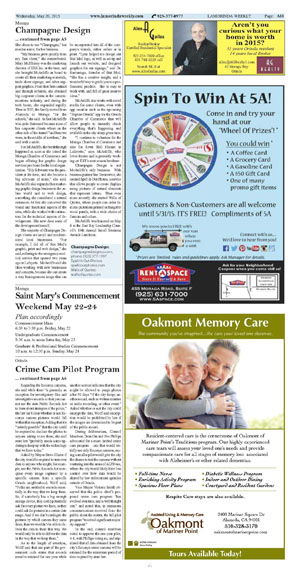|
|
Published May 20th, 2015
|
Council Approves One-Year Crime Cam Pilot Program
|
|
| By Laurie Snyder |
|
|
Orinda residents shared a wide range of opinions for and against the installation of security cameras leading up to the Orinda City Council meeting May 5. Some quoted Benjamin Franklin: "Those who would give up essential Liberty, to purchase a little temporary Safety, deserve neither Liberty nor Safety." Others seemed less concerned. "I don't think you have a right to privacy in a public space," one resident said. "Just get on board with everybody else because it's going to happen, and it's not George Orwell and all this other stuff. It's just the way the reality of it is today because we're on TV all the time, we're in the public eye no matter where we go."
 Once again, council members deliberated whether or not to install security cameras inside city boundaries, and once again they probed the minds of city staff and average citizens as they weighed the sincere privacy concerns of those worried about the government's increasing use of surveillance on Americans against the very real fear felt by those whose homes have been burglarized.
Once again, council members deliberated whether or not to install security cameras inside city boundaries, and once again they probed the minds of city staff and average citizens as they weighed the sincere privacy concerns of those worried about the government's increasing use of surveillance on Americans against the very real fear felt by those whose homes have been burglarized.
 On May 5, the council considered Orinda Police Chief Mark Nagel's latest proposal - a one-year pilot program to install eight Reconyx cameras at Orinda's points of entry and neighborhoods where crime spikes, as well as to equip one police car with automated license plate reader (ALPR) technology which would link that car to county, state and federal databases that, theoretically, would help police catch suspects more quickly.
On May 5, the council considered Orinda Police Chief Mark Nagel's latest proposal - a one-year pilot program to install eight Reconyx cameras at Orinda's points of entry and neighborhoods where crime spikes, as well as to equip one police car with automated license plate reader (ALPR) technology which would link that car to county, state and federal databases that, theoretically, would help police catch suspects more quickly.
 According to the staff report, the Reconyx cameras would be purchased by the city at a cost of $6,730 with maintenance performed by a community service officer or other city employee with possible help from volunteers. The ALPR system would be covered by the city's contract with the Contra Costa County Sheriff's Department, and would be purchased from the same vendor used by CCSD and the City of Lafayette - Vigilant Systems - at a cost of $16,580.
According to the staff report, the Reconyx cameras would be purchased by the city at a cost of $6,730 with maintenance performed by a community service officer or other city employee with possible help from volunteers. The ALPR system would be covered by the city's contract with the Contra Costa County Sheriff's Department, and would be purchased from the same vendor used by CCSD and the City of Lafayette - Vigilant Systems - at a cost of $16,580.
 The cameras would be helpful, said Nagel, in the absence of DNA or fingerprint evidence. Reconyx camera data would likely be accessed by Orinda's police immediately after the commission of crimes, but could also be viewed later if residents discover problems after returning from vacation.
The cameras would be helpful, said Nagel, in the absence of DNA or fingerprint evidence. Reconyx camera data would likely be accessed by Orinda's police immediately after the commission of crimes, but could also be viewed later if residents discover problems after returning from vacation.
 The ALPR system would make a difference because it delivers real-time information that is shared by multiple agencies, including the U.S. Department of Homeland Security. "Vehicles associated with wanted subjects are not constrained by city limits," said Nagel. "Vehicles wanted in one city can easily travel through Orinda and by not sharing data, the police and the community at large would never know a vehicle associated with a list of crimes travelled through Orinda."
The ALPR system would make a difference because it delivers real-time information that is shared by multiple agencies, including the U.S. Department of Homeland Security. "Vehicles associated with wanted subjects are not constrained by city limits," said Nagel. "Vehicles wanted in one city can easily travel through Orinda and by not sharing data, the police and the community at large would never know a vehicle associated with a list of crimes travelled through Orinda."
 In response to multiple questions from council members regarding how long the city would be required to retain the photographs and other data obtained from ALPRs and city-owned crime cameras, as well as when and if the photos and data could be subject to public disclosure, city attorney Osa Wolff said the ALPRs would fall under CCSD policies, which requires that records be retained for one year.
In response to multiple questions from council members regarding how long the city would be required to retain the photographs and other data obtained from ALPRs and city-owned crime cameras, as well as when and if the photos and data could be subject to public disclosure, city attorney Osa Wolff said the ALPRs would fall under CCSD policies, which requires that records be retained for one year.
 Regarding the Reconyx cameras, she said while there "is generally an exception for investigatory files and investigative records so that you cannot use the state Public Records Act to learn about strategies of the police," the law isn't clear whether or not Reconyx camera pictures would fall within that exception. Adding that it's "entirely possible" that the city could be required to disclose the photos to anyone asking to see them, she said state law "probably needs some updating to keep up with the technology that we have today."
Regarding the Reconyx cameras, she said while there "is generally an exception for investigatory files and investigative records so that you cannot use the state Public Records Act to learn about strategies of the police," the law isn't clear whether or not Reconyx camera pictures would fall within that exception. Adding that it's "entirely possible" that the city could be required to disclose the photos to anyone asking to see them, she said state law "probably needs some updating to keep up with the technology that we have today."
 Asked by Mayor Steve Glazer if the city would be required to turn over data to anyone who might, for example, use the Public Records Act to request every image captured by a specific camera from a specific Orinda neighborhood, Wolff said, "Folks are entitled to records essentially in the way that we keep them. So, if somebody has a big enough storage device, they could potentially ask for every picture we have, or they could ask for pictures in a certain date range. And if we don't catalogue the pictures by which camera they came from, then we wouldn't be able to deliver the data to them that way. We would only be able to deliver the data in the way that we keep them."
Asked by Mayor Steve Glazer if the city would be required to turn over data to anyone who might, for example, use the Public Records Act to request every image captured by a specific camera from a specific Orinda neighborhood, Wolff said, "Folks are entitled to records essentially in the way that we keep them. So, if somebody has a big enough storage device, they could potentially ask for every picture we have, or they could ask for pictures in a certain date range. And if we don't catalogue the pictures by which camera they came from, then we wouldn't be able to deliver the data to them that way. We would only be able to deliver the data in the way that we keep them."
 As to the length of retention, Wolff said that one part of the government code states that records must be retained for one year while another section indicates that the city might be allowed to purge photos after 90 days "if the city keeps another record, such as written minutes or audio recording, or other event." Asked whether or not the city could encrypt the data, Wolff said encryption would be prohibited by law if the images are determined to be part of the public record.
As to the length of retention, Wolff said that one part of the government code states that records must be retained for one year while another section indicates that the city might be allowed to purge photos after 90 days "if the city keeps another record, such as written minutes or audio recording, or other event." Asked whether or not the city could encrypt the data, Wolff said encryption would be prohibited by law if the images are determined to be part of the public record.
 During deliberations, Council Members Dean Orr and Eve Phillips advocated for a more limited crime cam program - one that would initially use only Reconyx cameras, saying a smaller pilot would give the city the chance to test the cameras without venturing into the arena of ALPR use, where the city would likely have less control over how data would be shared by law enforcement agencies outside of Orinda.
During deliberations, Council Members Dean Orr and Eve Phillips advocated for a more limited crime cam program - one that would initially use only Reconyx cameras, saying a smaller pilot would give the city the chance to test the cameras without venturing into the arena of ALPR use, where the city would likely have less control over how data would be shared by law enforcement agencies outside of Orinda.
 Vice Mayor Victoria Smith observed that the police chief's proposed crime cam program "has evolved over time, and is well thought out," and noted that, in numerous communications received from the public about the matter, the full pilot program "received significant majority support."
Vice Mayor Victoria Smith observed that the police chief's proposed crime cam program "has evolved over time, and is well thought out," and noted that, in numerous communications received from the public about the matter, the full pilot program "received significant majority support."
 In the end, council members voted to approve the one-year pilot, 4-1, with Phillips voting no, and stipulated that all data obtained from the city's Reconyx crime cameras will be retained for the minimum period of time required by state law.
In the end, council members voted to approve the one-year pilot, 4-1, with Phillips voting no, and stipulated that all data obtained from the city's Reconyx crime cameras will be retained for the minimum period of time required by state law.

|
|
|
|
|
|
|
|
|
| |
|
|
|
|



